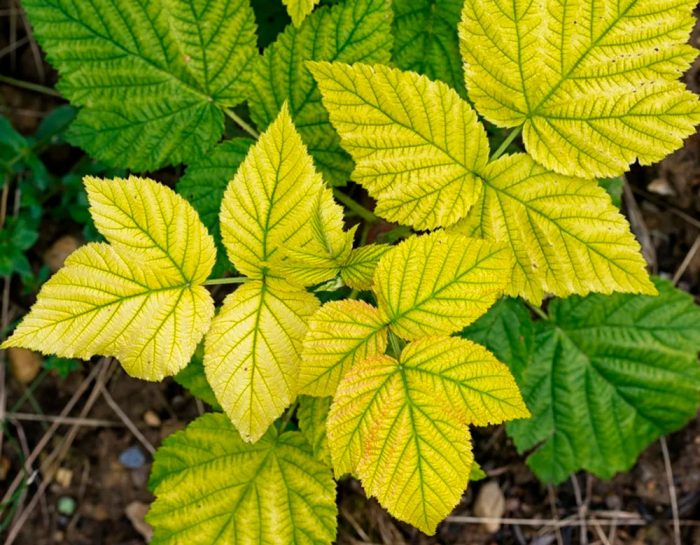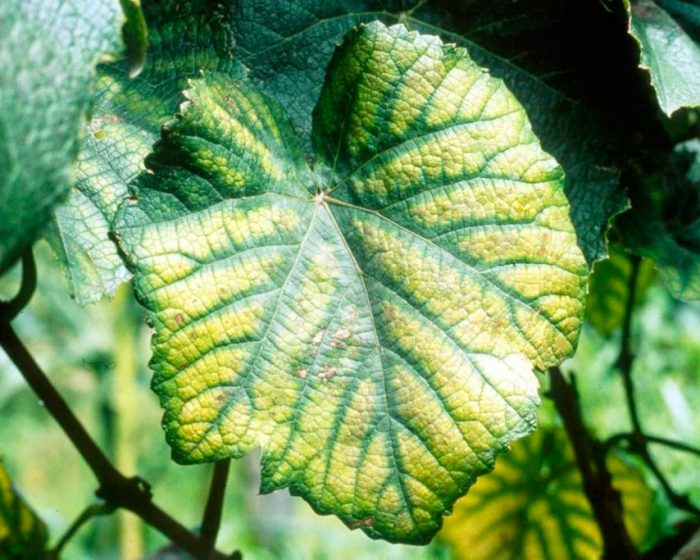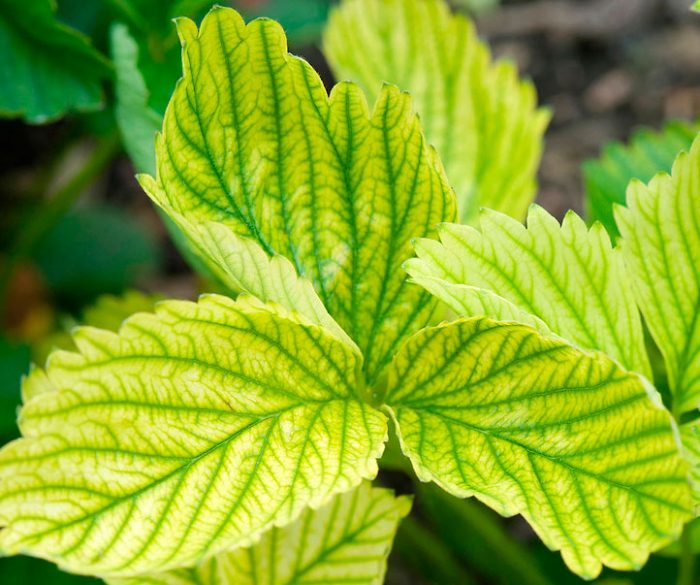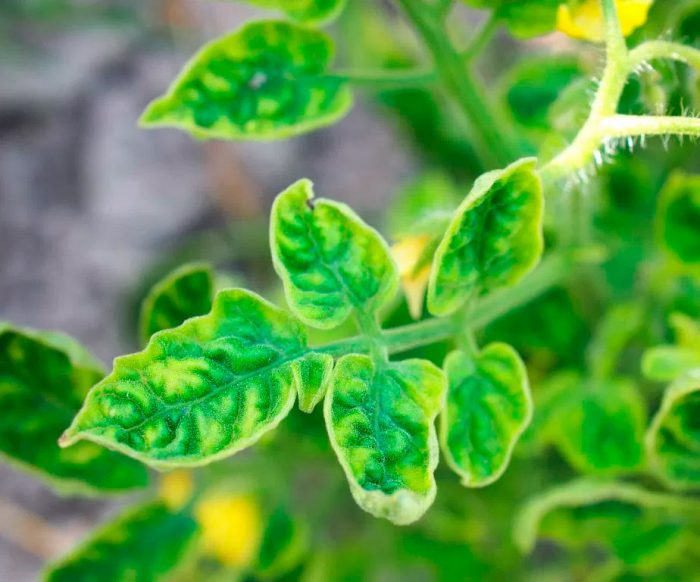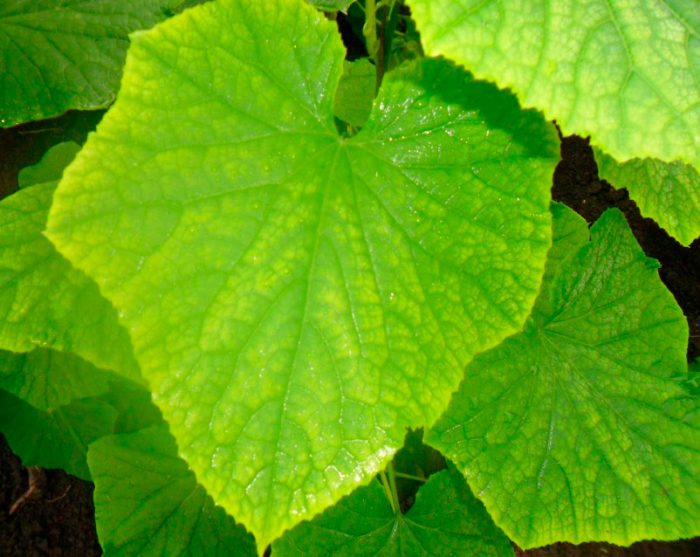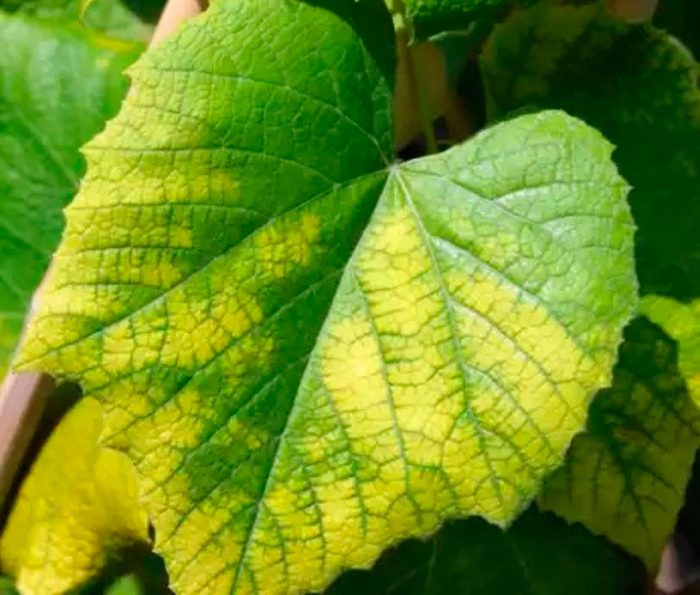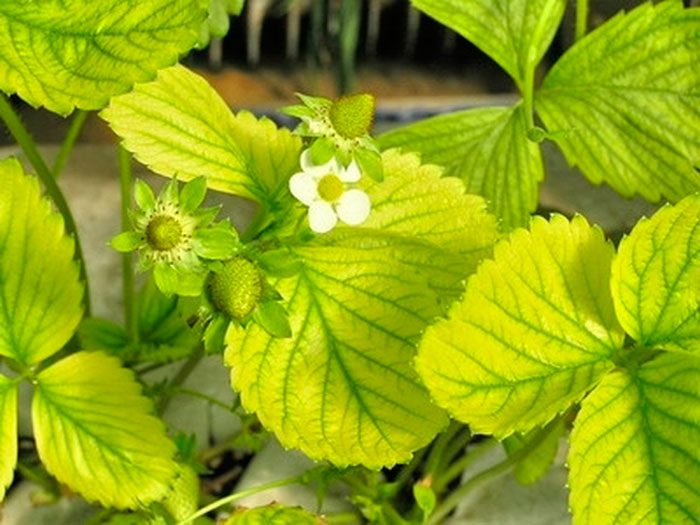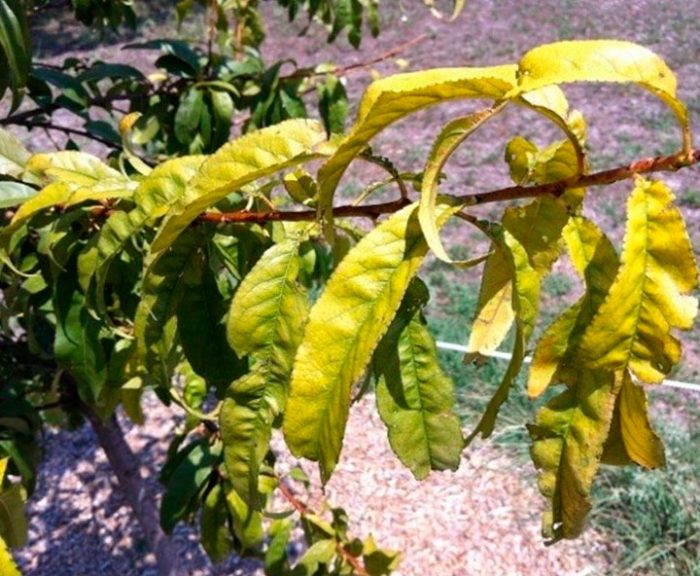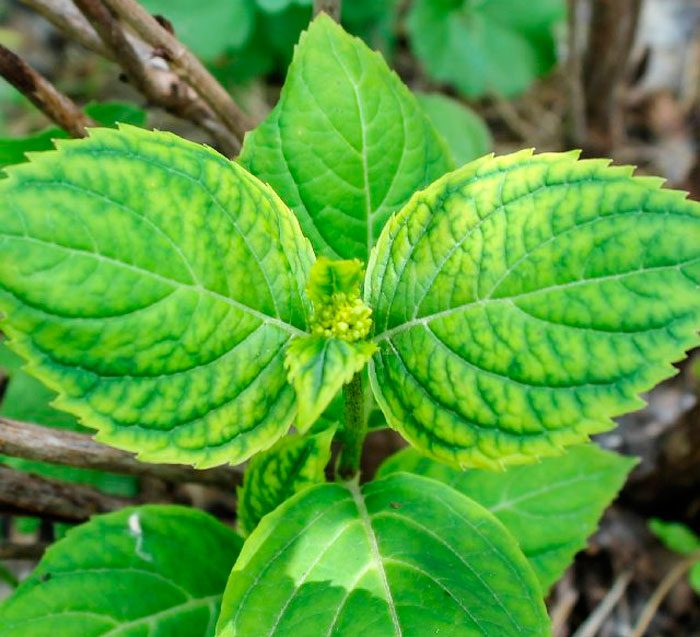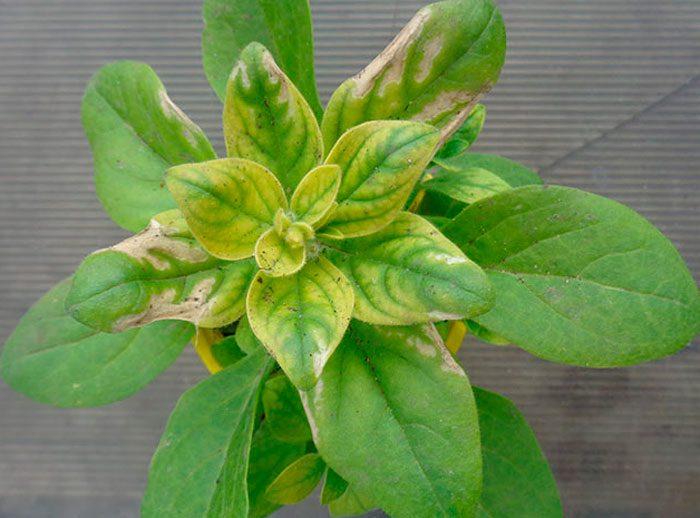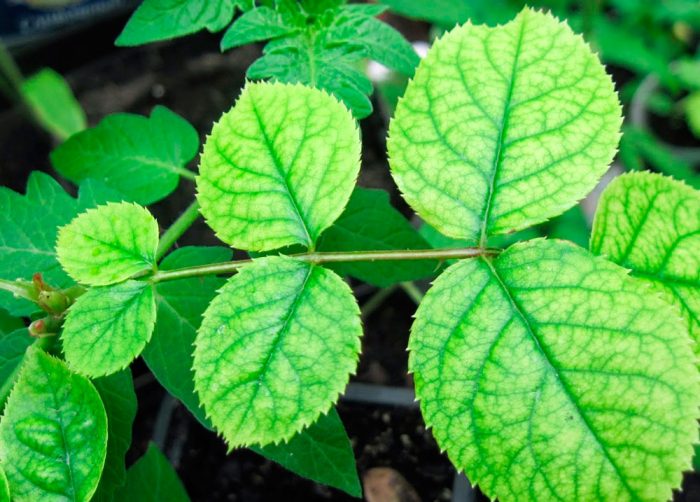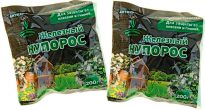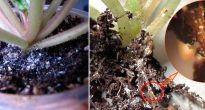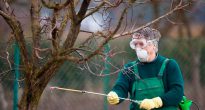Chlorosis is a plant disease. In the affected bushes, there is a violation of the formation of chlorophyll in the foliage and a decrease in the activity of photosynthesis.
Content
Features of chlorosis
The main symptoms of chlorosis are:
- young leaf plates turn yellow ahead of time, while the color of their veins remains green;
- foliage shrinks, which means that new leaf plates grow smaller than usual;
- the edges of the foliage begin to curl;
- flowers and leaves begin to fly around;
- the tops of the stems dry out;
- flowers and buds are deformed;
- the condition of the root system deteriorates significantly, and if the case is neglected, they can die out.
Chlorosis can develop for various reasons. For example, there is infectious chlorosis, the causative agents of which are viruses, fungi and other pathogenic microorganisms. Various pests are considered carriers of this disease. The development of non-infectious (organic) or functional chlorosis, as a rule, is associated with non-observance of the rules of agricultural cultivation. And also those plants that are grown on unsuitable soil or in unfavorable climatic conditions can be affected by chlorosis. For example, this may be due to a deficiency in the soil of magnesium, sulfur, nitrogen, iron, zinc, lime, proteins, or to the acidity level of the soil, at which the root system is unable to absorb the minerals needed by the plant. The development of non-infectious chlorosis can be caused by insufficient soil drainage, due to which there is a stagnation of fluid in the root system. And the disease can also be caused by trauma to the roots, thickening of the planting or exposure to sulfur dioxide. And this disease sometimes occurs as a mutation and can be inherited, this is often used by breeders to create variegated forms of ornamental plants.
Chlorosis treatment
If the plant is affected by non-infectious chlorosis, then in order to cure it, the bush is fed with the missing elements. Cultures are fed both by the root method and by foliage, spraying the bushes with a solution of micronutrient fertilizers. You can also inject the nutrient mixture directly into the branches or stem.
To cure chlorosis, you need to know which drugs to use for this. If the soil has a low iron content, then the following agents are used to treat crops: Ferovit, Ferrylene, Micro-Fe or Iron Chelate.The lack of magnesium in the soil can be corrected by adding magnesium sulfate, dolomite flour or Mag-Bor. With a lack of sulfur, Azofoska with sulfur, Kalimagnesia, Diammofoska with sulfur or potassium sulfate are used, please note that in addition to sulfur, such products include phosphorus, sodium, magnesium and nitrogen (remember that during flowering, it is extremely difficult to add nitrogen to the ground recommended). With a lack of zinc in the earth, zinc oxide, zinc sulfate or superphosphate with zinc are added to it. And with a lack of calcium, wood ash, egg shells or slaked lime are added to the soil. Remember that ammoniacal nitrogen helps to reduce the intake of calcium into plant tissues, while nitrate nitrogen increases.
When a plant is damaged by infectious chlorosis, one must remember that it is incurable. Therefore, when a diseased bush is found, it is dug up and destroyed as soon as possible, otherwise the nearby bushes may be affected by chlorosis.
Prevention
In order to prevent the development of chlorosis, experts advise that organics and mineral fertilizing should be introduced into the soil in a timely manner. If you do not know which element in the soil is very small, then a complex fertilizer is introduced into it, which contains all the substances necessary for plants, for example: Florist Micro, Kemira Lux, Uniflorom Micro, etc.
The main measures for the prevention of viral chlorosis include:
- disinfection of garden tools with industrial alcohol or boiling before use, as well as after;
- disinfection of soil before planting or sowing;
- dressing seeds or planting material with solutions of a fungicidal preparation;
- timely pest control.
Chlorosis of garden crops
Chlorosis of tomatoes
An excessively slow development and growth of a tomato, as well as curling, yellowing and flying of foliage can be symptoms of an acute lack of moisture, however, signs of non-infectious chlorosis also look. You can understand which element tomatoes need by the following criteria:
- Lack of nitrogen - the bushes grow slowly, there is a rapid lignification of the stems, and the old leaf plates first become faded, and then turn yellow. As for the fruits, they grow small, but ripen very quickly.
- Lack of phosphorus - the growth of the bush slows down and the main shoot becomes thinner, the foliage becomes smaller and acquires a characteristic purple hue, its edge becomes curved. Then leaf necrosis develops, and they begin to fly around.
- Potassium deficiency - for old leaf plates, the edge looks like a burnt, later yellowing of the foliage and its flying around is observed. After that, young foliage also falls ill with chlorosis. The inside of the fruit has black-brown stripes.
- Lack of calcium - at first, the upper leaf plates suffer: they turn yellow, deformation of young foliage also occurs, point necrotic areas form on it, eventually merging with each other. Further, the fruit is damaged by apical rot.
- Lack of copper in the soil - as a rule, this is observed when tomatoes grow on peaty soil. Gradually, the old foliage turns white, and the young leaf plates become smaller, the stems weaken, the underdeveloped flowers fly around.
- Boron shortage - because of this, growth points can begin to die off and a lot of lateral shoots can form, which is why the plant becomes abnormally bushy. Dry patches form on the surface of the fruit.
- Magnesium deficiency... Greenish-yellow specks form on the surface of old foliage, which eventually turn gray and then brown. The foliage is drying and flying around, the fruits grow small and ripen very quickly.
In the fight against chlorosis, first you need to determine what kind of elements the tomatoes need, and add it to the soil or spray the tomatoes over the foliage with a nutrient solution that contains this element. However, if the plant is infected with viral chlorosis, then dig it up and destroy it as soon as possible, and the soil in which it grew must be spilled with a solution of potassium permanganate or a fungicidal preparation.
Chlorosis of cucumbers
Due to chlorosis in the leaf plates of cucumbers, the edge and veins turn yellow, and this is not a direct sign of iron deficiency in the soil. It is very difficult for a layman to understand the cause of the development of the disease, it is also difficult to fight it, and on this you can spend too much time and be left without a crop at all. In this regard, it is much easier and easier to prevent the development of the disease. To do this, half a month before planting seedlings or sowing seeds, plant humus is introduced into the ground, the fact is that:
- the composition of such humus includes nutrients necessary for the normal growth and development of cucumbers;
- humus will be able to convert those elements that the plant needs into a soluble form;
- in comparison with mineral fertilizer, humus does not contain substances that can harm plants.
Apply a large amount of compost to a depth of 50–70 mm, after which the soil is spilled and left for several days. Only then can you start planting seedlings or sowing seeds.


Watch this video on YouTube
Chlorosis of fruit crops
Chlorosis of grapes
Many gardeners also call chlorosis on grapes pale sickness. In the affected bush, a gradual decrease in the ability to carry out photosynthesis occurs, as well as a slowdown in growth and a sharp deterioration in yield.
Most often, the development of non-infectious chlorosis is associated with an alkaline reaction of the soil, because of this, the root system is not able to normally absorb iron. However, in addition to carbonate chlorosis, this culture can be affected by magnesium, sulfuric, manganese, zinc or copper chlorosis. Also, the onset of the development of the disease may be associated with the accumulation of hydrogen sulfide in the soil, this is often observed on heavy soil with poor drainage, especially in cold and damp weather.
The causative agent of infectious chlorosis on grapes, which is also called yellow mosaic, is a parasitic nematode worm. But fortunately, grapes are rarely affected by such a disease.
The symptoms of foliar chlorosis are as follows: specks appear between the veins on the leaf plates, painted in various shades of yellow (from cream to lemon). Discoloration of old leaf plates is observed, while young foliage acquires a pungent yellow tint, its development stops. The foliage dries up and flies over time, on young shoots the internodes grow shortened, and the fruits in clusters become smaller. In general, chlorosis has an extremely negative effect on the frost resistance of the plant. The most pronounced signs of chlorosis are seen in spring and in the last summer weeks.
To understand that grapes are affected by non-infectious chlorosis, any pattern with Iron Chelate is applied to the surface of its discolored leaf, after 24 hours it should appear on a faded plate with a rich green color. It will take a whole range of measures to cure non-infectious chlorosis. In order to prevent the development of this disease, one should not forget about preventive measures:
- Experts recommend that for growing to choose those varieties that are highly resistant to this disease, for example: Muscatel, Cabernet, Saint Laurent, Elbing, Pinot Meunier, Trollinger, Riesling, Traminer, Pinot Noir, Limberger, etc. Most of all the Sylvaner variety is susceptible to white sickness. Remember that American grapes are less resistant to chlorosis than European ones.
- In order to significantly reduce the risk of chlorosis in bushes, it is recommended to sow crops around them that improve the chemical composition of the soil, for example: alfalfa, clover or green manure grains.
If the grapes were nevertheless affected by such a disease, then it will need to be fed with iron vitriol, and do not forget to treat the foliage with iron salts. Thanks to this, you will be able to restore normal photosynthesis, but it is impossible to completely cure plants from chlorosis in this way. In addition to the fact that the bushes must be regularly sprayed (1 time in 7 days), it will be necessary to improve the drainage and ventilation of the soil, for this they dig up the soil in the aisles, and cover it with a layer of mulch on top. Potassium sulphate and ferrous sulfate are used to eliminate alkalization of the soil. To cure lime chlorosis, iron is used in a chelated form, the foliage is moistened from a sprayer with a solution of sulfuric acid, and ammonium sulfate is added to the soil. In springtime, add 500 g of ferrous sulfate to each plant. Also try to feed the plants with phosphorus-potassium fertilizers in a timely manner, and also carry out regular foliar dressing with a solution of trace elements (zinc, manganese, etc.).
If you notice symptoms of yellow mosaic on the grapes, then try to remove it from the site as soon as possible and burn it. The fact is that such a bush will give a very meager harvest, but at the same time it can infect other specimens. As a preventive measure, spray the plants and the surface of the soil around them during flowering with iron sulfate.
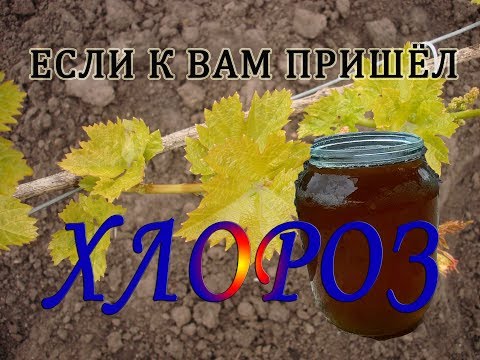

Watch this video on YouTube
Raspberry chlorosis
Raspberries can also be affected by infectious and non-infectious chlorosis, which develops due to a deficiency of certain elements or due to the unsatisfactory condition of the soil, due to which the root system is unable to assimilate the substances in the soil. The development of organic mosaics can begin, for example, if you pour cold water on the raspberries. You can recognize this disease on a plant by the following symptoms: spots of a yellow or light shade are formed on the leaf plate, they gradually grow and connect with each other until they completely cover the leaf. Then spots appear on the surface of the stems. If the plant is sick with viral chlorosis, then it must be dug up and burned.
In order to prevent the appearance of a viral mosaic on raspberries, the following preventive measures should be followed:
- for planting, use completely healthy planting material and it is better if it is resistant to chlorosis;
- promptly remove weeds and loosen the soil surface;
- add nutrient solutions to the soil on time;
- damp areas must be drained;
- carry out timely control of sucking pests, which are considered the main carriers of viral infections.
In the spring, before the buds open, the bushes are treated for aphids, a solution of Nitrafen (3%) is used for this, and shortly before flowering, the plants are treated with a solution of Methylmercaptophos (when preparing the solution, follow the manufacturer's instructions). Re-processing of Methylmercaptophos is carried out no later than 45 days before harvest.
To cure non-infectious chlorosis, you first need to understand why it appeared. If the development began due to alkalization of the soil, then gypsum should be added to it (per 1 square meter from 100 to 120 grams), and if the fault is excessively high humidity, then they resort to reducing watering. For irrigation, use well-settled water warmed up in the sun. Remember that with chlorosis, the bushes are fed mainly with nitrogen-containing fertilizers. It is highly undesirable to introduce fresh manure into the soil; the amount of potash fertilizers should also be limited (use the minimum dosage).Very effective in combating organic chlorosis is the method of introducing humus, peat, forest litter or compost into the soil. And also the raspberry can be watered with a solution of bird droppings (1 part of droppings for 10-12 parts of water).
Strawberry
The development of chlorosis on strawberries is due to the same as on raspberries (see above), and the symptoms of this disease in these plants are the same. For the treatment and prevention of organic chlorosis, the development of which occurs due to a lack of iron, garden strawberries are sprayed with a solution of organic live farming, for example: Ferovit or Helatin. To prepare a solution for 10 liters of water, approximately 12 milligrams of the drug are taken. It should be poured gently at the root. For spraying foliage, a solution of ferrous sulfate is used. Immediately after the first signs of chlorosis are detected, the bushes begin to be treated and watered with products containing iron.
Most often, the development of chlorosis occurs after liming of the soil, especially if too much lime has been added to it. Also, the content of large amounts of copper in the soil may contribute to this, since it is considered an iron antagonist. In order to know for sure that the development of the disease is caused by an iron deficiency, a number should be written on the yellowed leaf plate with Iron Chelate. If the plant really does not have enough iron, then after 24 hours the drawn figure will appear rich green.
Experts do not advise treating infectious chlorosis, since there are currently no effective drugs for it, but you will miss precious time and the virus will spread to other bushes. A characteristic feature of this disease is not only yellowing of the stems and leaf blades, but also the formation of excessively short internodes. Young stems and foliage of the affected bush may form green, but this does not mean that the plant has recovered, since viral chlorosis is incurable.


Watch this video on YouTube
Apple tree
Apple trees can also be affected by chlorosis. In this case, spots of a yellow or light shade are formed on the surface of the foliage, and the veins on the foliage remain green. After this, the tops of the leaf plates die off. As in the case of other crops, organic chlorosis of apple trees most often develops due to a deficiency of iron in the soil or due to the condition of the soil, due to which the root system of the plant is not able to normally assimilate this element. But before you start treating the apple tree, you need to make sure that the disease is caused by a lack of iron: in this case, the foliage begins to turn yellow from the tops of the stems. The affected tree is sprayed with Iron Chelate 2 or 3 times with an interval of 10-12 days or with such means as: Agrecol, Ferovit or Brexil. You also need to improve the composition of the soil, for this, the near-trunk circle is spilled with a solution of ferrous sulfate (100 grams per 10 liters of water). If the plant feels a very strong iron deficiency, then in this case, the trunk is injected with iron sulfate. To do this, a not very large hole is drilled in the barrel, into which the drug is poured, then the hole is covered with cement.
If the pale foliage is located at the bottom of the branches, this means that chlorosis develops due to a lack of nitrogen. In this case, fertilizers containing nitrogen are used to treat the apple tree, and it is better if they are organic. For example, you can use the following fertilizers:
- In the affected tree, 5 kilograms of cow manure must be added to the soil of the trunk circle, which must be rotted.
- If the foliage in the middle of the shoots turns yellow in young apple trees, this is caused by a deficiency of potassium. In this case, potassium sulfate is added to the near-trunk circle (25 grams per 1 square meter).
- A strong yellowing of the leaf plate between the green veins, as well as the presence of dark dots on the leaf and a necrotic border, suggests that the plant lacks magnesium and manganese. Wood ash and dolomite flour are added to the tree trunk circle, and the foliage is sprayed with a solution of magnesium sulfate (150 grams per 10 liters of water) and manganese sulfate (0.05%).
- If there is a general yellowing of all the foliage, then this indicates a lack of oxygen and sulfur in the root system of the plant. In this case, ammonium, potassium or magnesium sulfate, manure, gypsum, Ammofosku or humus are introduced into the soil. And to improve aeration of the roots, it is necessary to regularly loosen the soil surface in the near-stem circle and sprinkle it with a layer of mulch (organic material).
To understand why the plant got sick with chlorosis is quite simple only at the initial stage of its development. After the entire tree is completely affected by the disease, it will be very difficult to understand the cause of its development.
Viral chlorosis of apple trees is presented in two forms: chlorotic ring spot and mosaic. These two diseases are caused by different pathogens. In a tree affected by the mosaic, chloroticity is manifested both on the foliage and on the fruits, as well as on the stems, while it is represented by pronounced stripes and specks. There is a delay in fruiting and a decrease in yield by almost 2 times. With annular spotting, a point yellowing of the leaf plates appears. Small spots that have lost their green pigment form rings on both foliage and fruits. Foliage deformation and tree growth retardation are observed, shoots are also shortened, and the trunk does not become thicker. Such an apple tree becomes less resistant to frost. An interesting fact is that viral diseases, which often affect cherries, plums and raspberries, develop relatively rarely on apple trees.
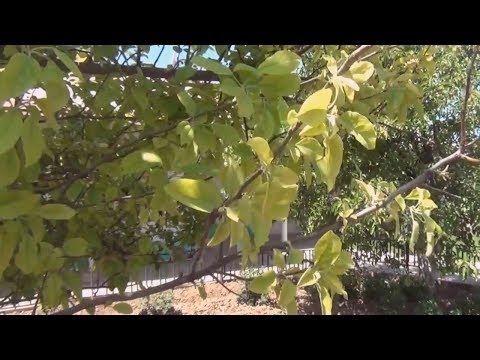

Watch this video on YouTube
Peach
The peach tree is highly susceptible to iron deficiency, and therefore it is highly susceptible to chlorosis. Initially, the foliage turns yellowish-green, after which chlorotic signs appear both on the leaf blade itself and on the veins. Over time, the entire crown is seized by chlorosis, which leads to premature flying around the foliage, and the tops of the shoots also begin to die off. Affected peaches become less cold-resistant, and in the next season they experience a deterioration in the formation of shoots and gum flow: the bark breaks and a crack forms, from which glue is released, the branches also dry out, and no growth is formed. The adhesive capsules are removed with a very sharp pre-disinfected knife. Next, clean the wounds and decontaminate them with a pinkish solution of potassium manganese, then rub them with the foliage of sorrel (horse or food) and coat with a mixture of fresh mullein and clay (1: 1), or you can use one clay.
To cure a tree directly from chlorosis, or rather, to eliminate iron deficiency in the soil, you should use the same methods as in the treatment of apple chlorosis.
Chlorosis of flowers
Chlorosis of hydrangeas
Garden hydrangeas are most often affected by chlorosis due to insufficient iron in the soil. If the gardener does nothing to cure the bush, then his metabolism will be disturbed, which will lead to its weakening, the foliage will turn yellow and fade, and the veins will remain green. Chlorosis, like other diseases, is much easier to prevent using preventive measures than to then cure the plant affected by it. If symptoms of such a disease appear on the flower, then its foliage is sprayed with Iron Chelate as soon as possible or with such a remedy as: Agrecol, Micro Fe, Brexil, Ferovit or Ferrylene. In the event that the bush is very badly affected, then the products containing iron are introduced into the soil directly under the root.The following method is quite effective in the treatment of hydrangea chlorosis: the soil around the bush is spilled 2 or 3 times with a solution of potassium nitrate or ferrous sulfate (40 grams of any of the substances are taken for 1 liter of water).


Watch this video on YouTube
Chlorosis of petunias
You can understand that petunia is sick with chlorosis by the following signs: yellowing of the foliage, while the veins remain green, the edge of the leaves curls and they fly around, and new leaf plates become smaller, and the flowers are deformed. The dying off of the root system and drying of the upper parts of the shoots are also observed. As soon as the first signs of chlorosis are found, a little citric acid is poured into the water for irrigation (½ tsp is poured into 1 liter of water). However, if there are no noticeable improvements, then iron sulfate is also poured into the citric acid solution (for 1 liter of solution ½ tsp). In this way, the soil is shed around the bush regularly until young healthy leaves begin to appear on the bushes. In order for the bush to recover faster, all the buds should be plucked from it, before they open. You can replace ferrous sulfate with other means, which include iron. Some gardeners also advise using foliar dressing with micronutrient solutions. However, such a flower does not tolerate even raindrops very well, so such treatments can harm it. Petunias affected by viral chlorosis must be dug up and destroyed.
Roses
You can understand that the rose is affected by chlorosis by the even yellowing of the leaf plates and the rich green veins on them. The reason for this may be a lack of iron in the soil, and these changes can also be observed if the bush was overfed with chemical fertilizers last season. Gardeners have noticed that out of two bushes growing side by side, one may feel iron deficiency, while the other looks quite healthy and grows normally.
Chlorosis treatment should be started in early spring before the growing season begins. To do this, humus or mullein and a deficient element should be added to the soil under the plants. Further, nitrogen-containing fertilizers are not used to feed diseased bushes, while watering should be poor, and also feed the roses in the foliage with a solution of complex fertilizer on a cloudy day until the bushes are completely healthy. During this period, you can not carry out a strong anti-aging pruning of the plant.
Chlorosis drugs
The following will describe those drugs that are used to treat non-infectious chlorosis:
- Iron chelate... This micronutrient contains iron in a chelated form, which is completely absorbed by plants.
- Helatin... The composition of such a microfertilizer includes iron in a chelated form, it is used for root dressing, and also for spraying over foliage in the treatment of chlorosis.
- Ferovit... Such a universal stimulator of respiration and photosynthesis of crops is used both for treatment and for the protection of vegetable, ornamental, indoor and fruit crops from chlorosis. The preparation contains iron chelate in high concentration.
- Brexil... This is a series of micro- and mesoelements, as well as their compounds in a chelate complex, which are specially designed for the prevention and treatment of chlorosis, they are used for foliar feeding. This series includes the following products: Brexil Ca (with calcium content), Brexil Mg (magnesium), Brexil Mn (manganese), Brexil Fe (iron), and so on.
- Iron vitriol (ferrous sulfate-II)... This agent is a contact fungicide, antiseptic and microfertilizer, which contains iron in a chelated form.
- Orton Micro-Fe... Such a micronutrient fertilizer for foliar dressing is considered universal, and it is suitable for garden and garden plants, it contains both trace elements and iron in a chelated form, which help fight chlorosis and increase the resistance of crops to diseases and adverse environmental conditions.
- Ferylene (Ferrylene)... Such a chelated universal fertilizer is used for fertilizing the foliage of fruit and berry, vegetable and ornamental plants, as well as flowers. It helps to improve the synthesis of chlorophyll in bushes.
- Agrecol... It is a concentrated multicomponent mineral fertilizer for balcony, indoor and garden crops, which helps in the fight against chlorosis when there is a lack of iron in the soil.
Folk remedies
To date, there are no effective folk remedies for the treatment and prevention of chlorosis. However, there is one unusual way to help sick plants: nails covered with rust are buried in the soil under the bush. There are reviews that this method was very effective even when all the drugs were powerless.


Watch this video on YouTube

